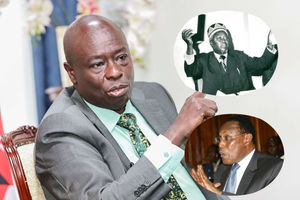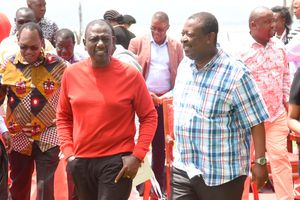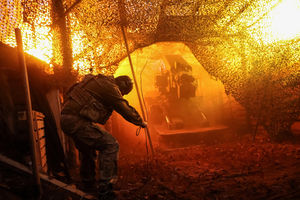
President William Ruto (left), DP Rigathi Gachagua and Prime Cabinet Secretary Musalia Mudavadi.
Prime Cabinet Secretary Musalia Mudavadi publicly talks of enhanced cooperation between his Amani National Congress (ANC) and the United Democratic Alliance (UDA) of President William Ruto in order to strengthen the governing Kenya Kwanza coalition.
While remaining coy on the details, he promised another ‘earthquake’ in the offing, sparking off a series of reports that he is about to fold ANC and formally lead his troops into UDA.
That would indeed be an earthquake signaling a definite shift in the governing coalition hierarchy and deeply unsettle Deputy President Rigathi Gachagua, especially in light of the quiet succession tussle.
Within a short time, however, top ANC officials dismiss talk of any intention to dissolve the party or merge with UDA, insisting that Mudavadi’s comments were misinterpreted. Mudavadi himself has since remained mum on the matter. Efforts to reach him for clarification were futile as he didn’t answer telephone calls or reply to text messages from The Weekly Review. However, there can be no doubt that his tantalizing hints about a major move in the offing could not have been misinterpreted.
Mudavadi is a very cautious politician who thinks through very carefully any word he utters in public. He would have known that reference to an impending ‘earthquake’ would be interpreted akin to the major political re-alignment he pulled at the ANC delegates conference at the Bomas of Kenya ahead of the 2022 elections. That was when he pulled out of the presidential elections to make way for then Deputy President Ruto, the surprise chief guest at the event.
The move caught Mudavadi’s colleagues in the One Kenya Alliance, Wiper Party leader Kalonzo Musyoka and Kanu leader Gideon Moi off-guard. They had not been informed in advance, and walked out of the gathering on getting news that Ruto was on his way. Also taken aback were the Azimio coalition principals, opposition chief Raila Odinga and then President Uhuru Kenyatta, who had both been assiduously wooing Mudavadi and his Western Kenya colleague, Ford-Kenya leader Moses Wetang’ula, to board their train.
Presidential quest
It may have seemed at the time like a damp squib rather than an earthquake for Mudavadi to abandon his presidential quest and agree to play second fiddle to Ruto. There is no doubt now, however, that he and Wetang’ula snubbing overtures from Uhuru and Raila to join the Kenya Kwanza bandwagon decisively tilted the election.
They took with them a large chunk of the populous Luhya vote that was presumed to be Raila’s for the taking, and delivered victory for Ruto, extracting in the process key positions in the new government, Prime CS for Mudavadi and National Assembly Speaker for Wetang’ula. Mudavadi would know that speaking of another earthquake could only be in reference to a political move of comparable import, one that shakes up the national political equation.
Hence the interpretation, which he did not personally discourage, of a plan to dissolve ANC into UDA. Having surrendered the position of party leader on assuming cabinet office, Mudavadi left denials to little-known party functionaries who reflected ever-present fears of a personal and community political machine disappearing.
Like nearly all political parties in Kenya, ANC is first and foremost a special purpose vehicle for the political aspirations of its founder and leader. It is used to capture community political leadership leading to a negotiating platform on the national stage. That is as true of ANC and Ford-Kenya as it is of Raila’s ODM, Kalonzo Musyoka’s Wiper and the rump that remains of Uhuru’s Jubilee presently fronted by Jeremiah Kioni.
Floating tribal balloons
There would be many in the party leadership and the voter base in parts of Western Kenya who would be extremely nervous about the ANC being swallowed by a larger organisation. It follows that even before contemplating folding his outfit, whether by merger or a simple shift, Mudavadi would have to be very clear on what role he would have in UDA. This, in itself, indicates that before publicly testing the waters or floating trial balloons, he would have had direct talks with Ruto and secured concessions that offer him a superior platform than the limited one he occupies in a largely regional outfit.
President Ruto, no doubt, would remain unchallenged as party leader if his dream of subsuming the junior Kenya Kwanza partners is realised. Gachagua occupies one of the three deputy party leader posts, the other two being vacant. Mudavadi would presumably be guaranteed one slot, the import of which he would be at par with the Deputy President in the party hierarchy. Gachagua’s backers from the Mt Kenya region such as Nyeri Governor Mutahi Kahiga and Mathira MP Eric Mwangi were already expressing alarm at such an eventuality even before there was talk of Mudavadi entering the fray.
Building a strong, united political party that can stand the test of time instead of an outfit based on delicate alliances has been a Ruto priority for quite a while. With his sense of history, the president is aware that since demise of the ‘mama na baba’ independence party, Kanu, in 2002, no riling outfit has survived more than one term.
President Mwai Kibaki came to power in 2002 at the head of the National Alliance Rainbow Coalition, a grouping that incorporated his own Democratic Party and myriad other outfits including Ford Kenya then headed by his Vice President Kijana Wamalwa, and the Liberal Democratic Party of politicians, including Raila, that had bolted from Kanu. Remnants include Narc-Kenya headed by Raila’s 2022 running-mate Martha Karua and the original Narc headed by former Kitui Governor Charity Ngilu.
Kibaki successfully defended his seat in 2007 on a ticket of the Party of National Unity, yet another unwieldy assemblage of various outfits destined to last not more than one electoral cycle. In 2013 Uhuru Kenyatta was elected on a Jubilee coalition ticket made up his own The National Alliance (TNA) and his deputy Ruto’s United Republican Party (URP) as the main partners. Within the first term the Jubilee affiliate parties all folding into a merger that recaptured power as the Jubilee Party, but even he wound up URP, Ruto kept an insurance policy in UDA.
His caution was proved right when he fell out with Uhuru in the second term, the latter using his clout to take affective control of the ruling party and kick out his deputy’s key loyalists. Now it is apparent Ruto also wants to rule with backing of a strong, united party, where he cannot be held hostage by unruly or rebellious partners.
His minions in Kenya Kwanza and UDA have been at the forefront of canvassing for other coalition affiliates to dissolve and join the principal partner, a move desired to be consummated ahead of the party polls set to commence later this month. Mudavadi would be a prize catch, as would Wetang’ula, who however has not publicly broached the matter. There is a dozen or so other Kenya Kwanza affiliates, most of them briefcase or one-man operations with hardly a single parliamentary seat between them. They could easily be cast aside without consequences if they don’t opt against joining the planned mega-party.
They include the Pamoja Africa Alliance of Senate Speaker Amason Kingi; Maendeleo Chap Chap of Tourism CS Alfred Mutua, Chama Cha Kazi of Public Service CS Moses Kuria, and the late Kibaki’s former DP inherited by Attorney-General Justin Muturi.
Urging caution
Others are the Service Party of Laikipia East MP Mwangi Kiunjuri, Tujibebe Wakenya Party owned by former Kiambu Governor William Kabogo. Many in Mudavadi’s camp are urging caution, afraid of diminished roles for themselves in a constellation way bigger than a factional western Kenya grouping. They are also conscious that Mudavadi could lose crucial bargaining power if he went into a big outfit as just another politician rather than one controlling a critical base.
Mudavadi, however, prefers to see the bigger picture according to some of his key strategists speaking on condition of anonymity. It is probable that for him the allure is not just in a deputy party leader slot, but prime position come the Ruto Succession.
At the moment, he serves as Prime CS at the pleasure of the president and courtesy of a pre-election pact that could easily be torn up. If the National Dialogue proposals back by Ruto and Raila go through, Mudavadi’s role could transform to Prime Minister, a constitutional office in charge of day-to-day running of government. If there has already been overlaps and tensions between the offices of DP and Prime CS, elevation of the latter to PM could upturn the pecking order. And with that place Mudavadi in better position to stake his claim to the presidency after Ruto exists the scene.
Any move that displaces Gachagua, however, would also upset the infamous ‘shareholder’ administration dominated by the DP’s populous Kikuyu community and Ruto’s Kalenjin, both of which voted solidly for Kenya Kwanza, unlike Mudavadi’s perpetually divided Luhya.
The calculation, however, is that bringing the Luhya more firmly into the fold would not necessarily mean the Kikuyu are displaced, for they were already deeply committed to Ruto even before Gachagua was tapped as DP. There are many ambitious Mt Kenya leaders who owe their loyalty directly to Ruto, and are hungry and eager to step into any void of called upon.
Trial balloons have already been floated on possible alternatives to Gachagua from within the community, such as Kiharu MP Ndindi Nyoro, and more twists and turns can be expected in the run-up to the UDA polls.










